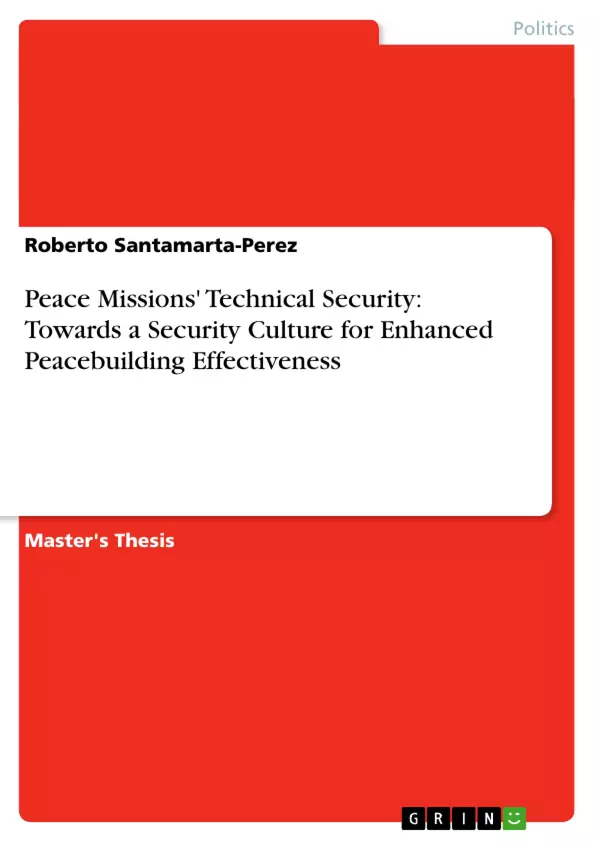Peacebuilding operations are organizational structures in emergency
environments or post-conflict areas working to restore and maintain stable
peace. The specificity of the geographical or political instability makes it
necessary for these entities to count on with technical security departments
in charge of securing the well-being of staff members and protecting
programs and assets. To effectively perform these tasks, mission internal
security departments produce a set of security regulations comprised in three
different operational blocks: security plans, security standard operation
procedures and contingency plans, and risk and threat assessments. These
norms are then communicated, trained on, and enforced to all mission staff
members.
Often staff members in peacebuilding missions disregard security
regulations, either conscious or unconsciously, causing secondary negative
effects on mission's operations, perceptions, and relations, and slow down or
even stop programs. Often, as well, technical security departments
employ a larger amount of time to enforcement than required due to lack of
compliance with security policy.
The aim of this study is to present a set of methodologies at the
operational, perceptual, and relational level that implemented and
coordinated by missions' technical security departments could positively
support and enhance missions' performance in security and safety, but
extrapolated to peacebuilding activities and mandate objectives.
It is understood and explained that security regulations can affect the
interoperability of a mission, in the sense that it can slow down and restrict
programs, especially in high risk environments. Therefore, the focus is
placed in peacebuilding operations with a moderate risk level, defined in the
United Nations language as Security Phases one and two.
Inhaltsverzeichnis (Table of Contents)
- Introduction
- Literature Review
- The theoretical framework
- The organizational structure of Peace Missions
- Technical Security within Peace Missions
- Research Methodology
- Findings and Analysis
- Security regulations and their relation to technical security departments
- The negative impacts of technical security
- Operational, perceptual and relational levels in technical security departments
- Recommendations
- Conclusion
Zielsetzung und Themenschwerpunkte (Objectives and Key Themes)
This study explores the potential of technical security departments in peacebuilding missions to positively impact overall mission effectiveness. It examines how security regulations, when implemented strategically and with careful consideration for their operational, perceptual, and relational implications, can enhance mission performance beyond just security and safety. Key themes explored in the text include:- The role of technical security departments in peacebuilding missions
- The impact of security regulations on mission operations, staff behavior, and peacebuilding objectives
- The need for a balanced approach to security that considers both the operational and relational aspects of peacebuilding
- The potential for technical security departments to contribute to a culture of security that supports effective peacebuilding
Zusammenfassung der Kapitel (Chapter Summaries)
- Introduction: This chapter introduces the study's focus on technical security in peacebuilding missions and highlights the challenges of balancing security needs with the broader goals of peacebuilding.
- Literature Review: This chapter presents a comprehensive review of relevant literature, outlining the theoretical framework for understanding technical security and its role in peacebuilding missions. It explores the organizational structure of peace missions and examines the specific challenges and considerations that arise in the context of technical security.
- Research Methodology: This chapter outlines the research methods employed in the study.
- Findings and Analysis: This chapter presents the findings of the research, analyzing the relationship between security regulations and the effectiveness of technical security departments. It explores the potential negative impacts of security regulations on mission operations and examines how these impacts can be mitigated through a more balanced approach to security.
- Recommendations: This chapter offers practical recommendations for improving the effectiveness of technical security departments in peacebuilding missions. It outlines strategies for developing a security culture that promotes both safety and operational effectiveness, and it explores ways to integrate security considerations into broader peacebuilding strategies.
Schlüsselwörter (Keywords)
This research focuses on the intersection of technical security and peacebuilding, exploring the potential for technical security departments to contribute to a more effective and holistic approach to peacebuilding. Key concepts include: peacebuilding missions, technical security departments, security regulations, security culture, operational effectiveness, relational dynamics, and the challenges of balancing security with peacebuilding objectives.- Citar trabajo
- Roberto Santamarta-Perez (Autor), 2012, Peace Missions' Technical Security: Towards a Security Culture for Enhanced Peacebuilding Effectiveness, Múnich, GRIN Verlag, https://www.grin.com/document/263035



